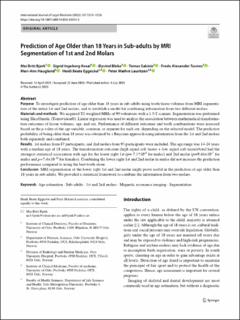Prediction of Age Older than 18 Years in Sub-adults by MRI Segmentation of 1st and 2nd Molars
Bjørk, Mai Britt; Kvaal, Sigrid Ingeborg; Bleka, Øyvind; Sakinis, Tomas; Tuvnes, Frode Alexander; Haugland, Mari-Ann; Eggesbø, Heidi Beate; Lauritzen, Peter Mæhre
Journal article, Peer reviewed
Published version
Permanent lenke
https://hdl.handle.net/11250/3119033Utgivelsesdato
2023Metadata
Vis full innførselSamlinger
Originalversjon
International journal of legal medicine (Print). 2023, 137 (5), 1515-1526. 10.1007/s00414-023-03055-5Sammendrag
Purpose To investigate prediction of age older than 18 years in sub-adults using tooth tissue volumes from MRI segmenta- tion of the entire 1st and 2nd molars, and to establish a model for combining information from two different molars. Materials and methods We acquired T2 weighted MRIs of 99 volunteers with a 1.5-T scanner. Segmentation was performed using SliceOmatic (Tomovision©). Linear regression was used to analyse the association between mathematical transforma- tion outcomes of tissue volumes, age, and sex. Performance of different outcomes and tooth combinations were assessed based on the p-value of the age variable, common, or separate for each sex, depending on the selected model. The predictive probability of being older than 18 years was obtained by a Bayesian approach using information from the 1st and 2nd molars both separately and combined.
Results 1st molars from 87 participants, and 2nd molars from 93 participants were included. The age range was 14-24 years with a median age of 18 years. The transformation outcome (high signal soft tissue + low signal soft tissue)/total had the strongest statistical association with age for the lower right 1st (p= 7.1*10-4 for males) and 2nd molar (p=9.44×10-7 for males and p=7.4×10-10 for females). Combining the lower right 1st and 2nd molar in males did not increase the prediction performance compared to using the best tooth alone.
Conclusion MRI segmentation of the lower right 1st and 2nd molar might prove useful in the prediction of age older than 18 years in sub-adults. We provided a statistical framework to combine the information from two molars.

